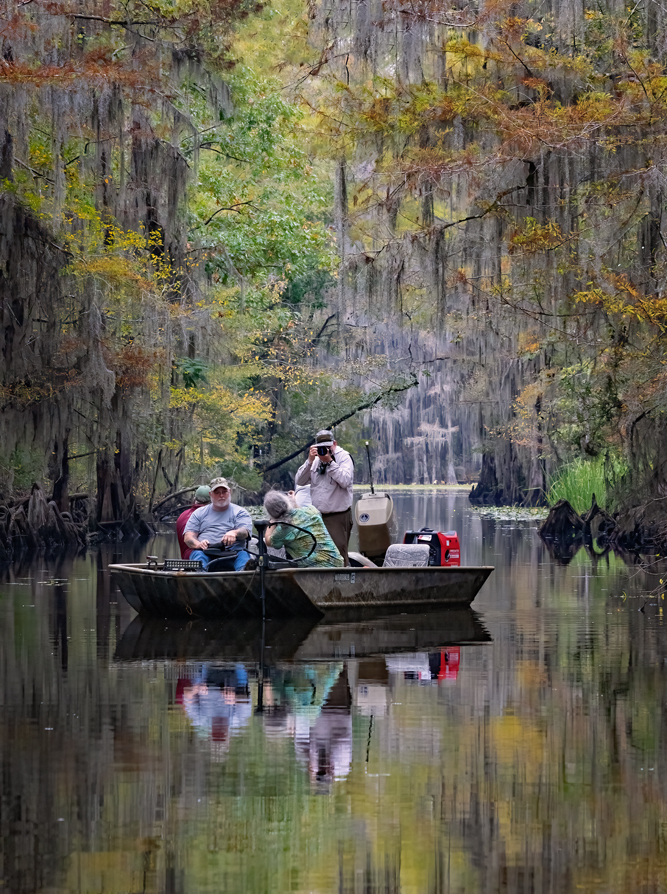My first adventure into the untamed realm of cypress swamps dates to my first year at university. I was part of a student group that embarked on a five-day canoe expedition through the Okefenokee Swamp in southern Georgia. This trip left a profound mark on me, as it was my first encounter with an environment that transported me back to what seemed like the primordial ancient forest from my imagination. Our maiden voyage into the world of cypress occurred during the spring revival. Cypress trees, though being conifers, shed their leaves in the colder winter months. The vibrant resurgence of greenery was a wonderful sight above the dark, tea-colored waters that our canoes glided over.

This photo tour of Caddo Lake would encapsulate all that I had initially experienced and much more. This journey would delve into the vibrant seasonal transformations that occur in the lakes, rivers, and bayous that these cypress trees inhabit. Caddo Lake, located on the border of Louisiana and Texas, is expansive (over 26,000 acres) yet shallow (approximately 8 feet deep), providing numerous channels and bays for cypress trees to anchor their roots. Despite its size, Caddo Lake is merely a fraction of the forest that attracted our group to this location for photography. During our stay, we explored many other smaller lakes and bayous in our photographic pursuit of autumn color.

Our photographic journey began in Shreveport, Louisiana, a location conveniently accessible for North American travelers. My co-leader and wife, Melissa Scott, and I easily gathered our group of photo enthusiasts at their Shreveport hotels. We then embarked on a brief 45-minute drive to our lodgings near Caddo Lake, the area that would be our photographic playground for the next four days.
Most nature photographers are aware that the transformation of foliage colors in autumn is typically induced by the chillier fall weather. Like much of the northern hemisphere, this year’s autumnal transition was delayed due to above-average temperatures in the region. Nevertheless, Melissa and I, with the assistance of our local guide and boat drivers, were confident that we could discover enough vibrant hues to keep our cameras busy.

Our strategy for the days of photography involved taking our travelers out each morning before dawn and again in the late afternoon, staying until dark to explore the area’s aquatic forests in search of vibrant landscapes and compelling compositions to capture. With two sturdy flat-bottom motorboats, piloted by two experienced drivers to navigate us through the labyrinth of backwaters, Melissa and I were able to focus on assisting our travelers in creating the iconic images that make this location truly unique.
Following a quick check-in at our hotel, we prepared for our first photo expedition. The weather forecast predicted rain, but we chose to embrace it and ventured to a popular land-based location in Caddo Lake State Park. This allowed us to capture our initial shots and evaluate the evening’s weather for our first boat journey into the lakes and bayous. The state park’s photography potential was so impressive, with the rain saturating the color of our vibrant compositions, that we opted for an evening boat ride to maximize our time on the water.
The heavy cloud cover presented a low-light challenge. However, the advanced ISO capabilities of today’s digital cameras provided us with an edge we lacked just a few years ago. As the rain steadily fell throughout the evening, it intensified the color saturation, serving as a reminder of how pushing one’s boundaries as a photographer can lead to the creation of exceptional images even under challenging lighting conditions.

Caddo is a sanctuary for introspection. Guided by our skillful boat guides, we discovered an array of colors and the intimate reflections that the waters of this area are renowned for. As we silently navigated these backwaters, captivating scenes unfolded in almost every direction.
Fortunately, the weather varied during our photo tour, and the subsequent two days presented different lighting conditions in drier weather, enhancing our time on the boats in the forested backwaters. On our third day, our boat drivers joined us for a journey into the larger expanse of Caddo Lake. Despite the trees around this part of the lake not showing much of the seasonal hues seen in the smaller lakes and bayous, it was a delightful experience capturing images of solitary cypress trees adorned with Spanish moss against the backdrop of Caddo’s open waters.

Throughout most of our stay at Caddo Lake, the temperatures remained warm. Our final evening boat tour concluded with a cool rain just as the sun was yielding to the night sky, heralding the onset of a cold front that would lower the next morning’s temperatures to the 30s, accompanied by heavy rainfall. At this juncture, the group decided that the previous boat trips had been so fruitful in terms of photography that it would be best not to venture out for more photos.
Establishing a photographic bond with a new location is always gratifying, and autumn at Caddo Lake is no exception. With this year’s boat tours already proving to be a tremendous success and the vivid hues of the cypress trees securely stored on our computers, we bid farewell to these tranquil backwaters until next year.




